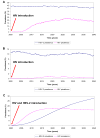HSV-2 serology can be predictive of HIV epidemic potential and hidden sexual risk behavior in the Middle East and North Africa
- PMID: 21352788
- PMCID: PMC3722433
- DOI: 10.1016/j.epidem.2010.08.003
HSV-2 serology can be predictive of HIV epidemic potential and hidden sexual risk behavior in the Middle East and North Africa
Abstract
Background: HIV prevalence is low in the Middle East and North Africa (MENA) region, though the risk or potential for further spread in the future is not well understood. Behavioral surveys are limited in this region and when available have serious limitations in assessing the risk of HIV acquisition. We demonstrate the potential use of herpes simplex virus-2 (HSV-2) seroprevalence as a marker for HIV risk within MENA.
Methods: We designed a mathematical model to assess whether HSV-2 prevalence can be predictive of future HIV spread. We also conducted a systematic literature review of HSV-2 seroprevalence studies within MENA.
Results: We found that HSV-2 prevalence data are rather limited in this region. Prevalence is typically low among the general population but high in established core groups prone to sexually transmitted infections such as men who have sex with men and female sex workers. Our model predicts that if HSV-2 prevalence is low and stable, then the risk of future HIV epidemics is low. However, expanding or high HSV-2 prevalence (greater than about 20%), implies a risk for a considerable HIV epidemic. Based on available HSV-2 prevalence data, it is not likely that the general population in MENA is experiencing or will experience such a considerable HIV epidemic. Nevertheless, the risk for concentrated HIV epidemics among several high-risk core groups is present.
Conclusions: HSV-2 prevalence surveys provide a useful mechanism for identifying and corroborating populations at risk for HIV within MENA. HSV-2 serology offers an effective tool for probing hidden sexual risk behaviors in a region where quality behavioral data are limited.
Copyright © 2010 Elsevier B.V. All rights reserved.
Figures



References
-
- Abu-Raddad L, Akala FA, Semini I, Riedner G, Wilson D, Tawil O, Fall F, Victor-Ahuchogu J. Characterizing the HIV/AIDS epidemic in the Middle East and North Africa. Time for Strategic Action. Middle East and North Africa HIV/AIDS Epidemiology Synthesis Project. World Bank/UNAIDS/WHO. 2010a.
-
- Abu-Raddad LJ, Hilmi N, Mumtaz G, Benkirane M, Akala FA, Riedner G, Tawil O, Wilson D. Epidemiology of HIV infection in the Middle East and North Africa. AIDS. 2010b;24(Suppl 2):S5–23. - PubMed
-
- Abu-Raddad LJ, Longini IM., Jr No HIV stage is dominant in driving the HIV epidemic in sub-Saharan Africa. AIDS. 2008a;22(9):1055–1061. - PubMed
-
- Abu-Raddad LJ, Patnaik P, Kublin JG. Dual infection with HIV and malaria fuels the spread of both diseases in sub-Saharan Africa. Science. 2006;314(5805):1603–1606. - PubMed
Publication types
MeSH terms
Grants and funding
LinkOut - more resources
Full Text Sources
Medical
Research Materials

